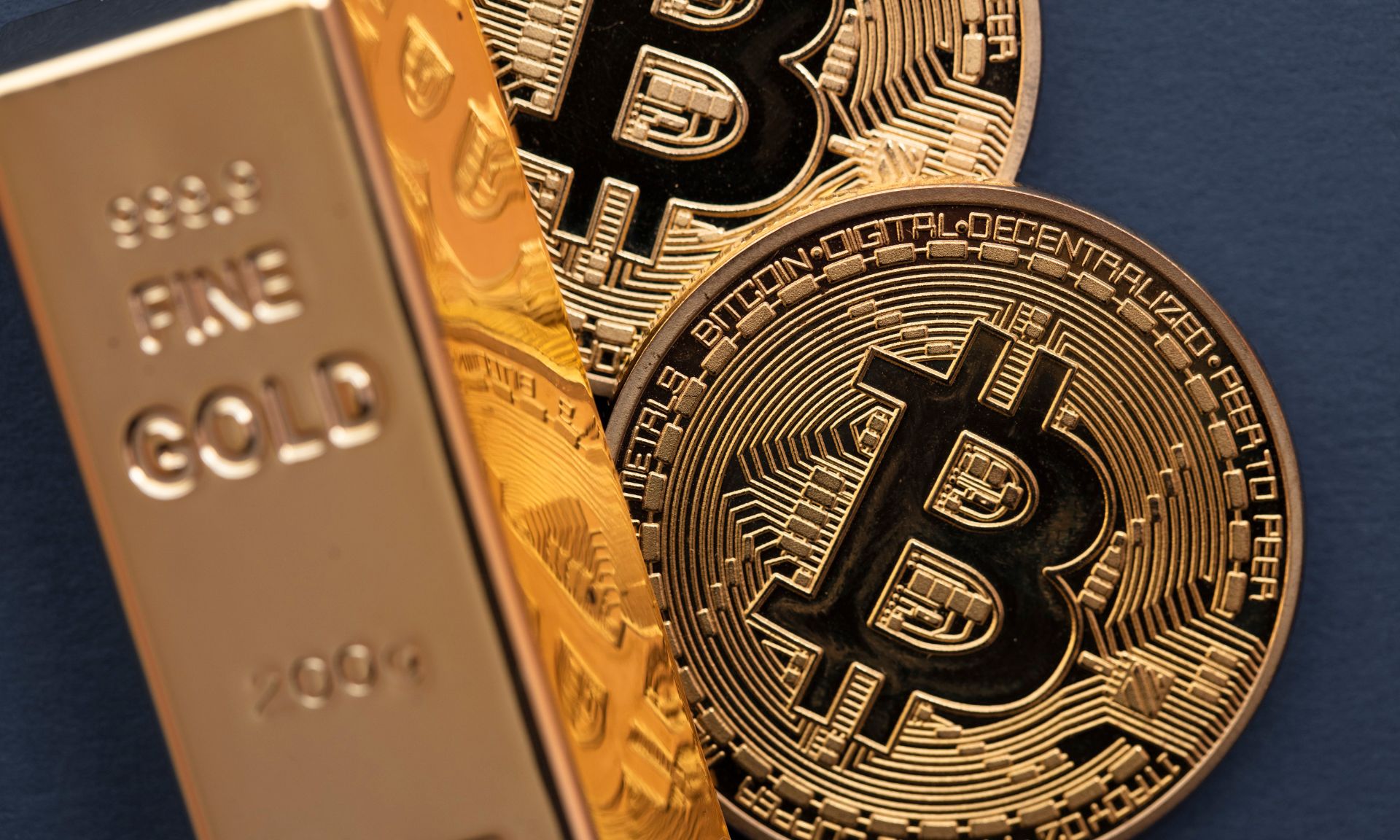With inflation in the United States recently reaching its highest level in over 40 years, investors are desperately seeking assets that can help safeguard their nest eggs from rising prices. Traditionally, gold has been viewed as one of the best inflation hedges available. But in the modern digital era, could Bitcoin provide comparable or even superior inflation protection compared to the yellow metal? There are no definitive answers yet, but analyzing their respective histories and investment merits sheds light on this emerging debate.
How Gold and Bitcoin Stack Up as Inflation Hedges

An inflation hedge is an investment designed to retain or even grow in real value during periods of rising consumer prices. The best hedges either benefit directly from inflation tailwinds or simply aren’t impacted much by inflationary dynamics.
When comparing any candidates for inflation protection, key criteria include:
- Track record – How has the asset performed during historical episodes of high inflation?
- Fundamentals – Does it have identifiable characteristics or investment merits able to combat inflation?
- Accessibility – How easily can investors gain exposure at a reasonable cost?
- Volatility – Are sharp price swings likely to erode inflation-adjusted returns over time?
Evaluated along these dimensions, gold boasts a far longer track record than bitcoin for maintaining purchasing power in the face of rising prices. But bitcoin’s digital scarcity still offers theoretical appeal.
Gold as an Established Inflation Hedge
Gold’s role as a store of value traces back thousands of years, surviving civilizations and empires thanks to unique physical properties preserving its intrinsic worth over millennia. In modern financial markets, gold has demonstrated historical effectiveness offsetting inflation:
- During 1973-1976 $150 per ounce gold climbed over $600 alongside severe stagflation with double-digit inflation.
- Another gold rally in 1979-1980 brought prices from $220 to $850 an ounce as yearly inflation exceeded 13%.
- Most recently, gold moved from approximately $1,500 per ounce in early 2020 to over $2,000 by mid-2022, outpacing CPI hovering near 9%.
As World Gold Council analyst Adam Perlaky notes, these real-world examples provide tangible evidence of gold maintaining purchasing power whenever inflation leaves the Fed’s comfort zone.
Underpinning gold’s anti-inflationary properties are basic supply/demand fundamentals: expanding fiat money supplies increase bullion’s relative scarcity, bolstering demand from investors seeking sanctuary from eroding cash savings. This flight to safety phenomenon typically intensifies whenever anxiety about monetary authorities’ inflation-fighting competency spreads.
Gold’s physical divisibility and portability also support demand elasticity across regions, demographics, and wealth distributions absent in larger real assets like property. Investors can gain direct price exposure through ownership of gold bullion across secure storage options fitting their budgets and preferences, from personal safes to insured third-party vaults internationally. Further financialization via gold-backed securities and derivative contracts enhances inflation-hedging accessibility without introducing prohibitive costs or lock-in periods.
In short, gold holds distinctive fundamental advantages explaining its enduring appeal whenever inflation unexpectedly accelerates. Its scarcity and intrinsic value offer reliable shelter from fiat currency debasement over multiple human generations so far.
Bitcoin’s Digital Scarcity Offers Theoretical Appeal
Unlike gold’s demonstrable track record measured over centuries, bitcoin only emerged following 2008’s financial crash, leaving questions around its inflation-fighting credentials. Still, its underlying “digital gold” investment narrative rests on a deliberately fixed supply capped at 21 million bitcoins:
- Bitcoin production is tightly controlled through clever algorithmic design, with new supply release gradually slowing over time. Its monetary issuance schedule mimics scarce precious metal ore extraction.
- Total circulation will approach asymptotic limits over the coming century, enabling holders to theoretically maintain purchasing power amid indefinitely expandable fiat supplies vulnerable to potential political interference.
- Additionally, up to 20% of existing bitcoins are essentially lost forever thanks to forgotten keys, rendering remaining coins rarer still. This shrinkage probably continues indefinitely.
Supporters argue this strictly enforced digital scarcity makes bitcoin an ideal beneficiary whenever anxiety spreads about authorities debasing national currencies to temporarily juice growth at the expense of savers. As trust erodes in the competency and restraint of central bankers and policymakers, a fixed-supply crypto asset disconnected from incumbent oversight offers theoretical sanctuary.
Effectively decentralizing the roles of exchange facilitator, ledger keeper, and currency manager tempers opportunities for small groups of influential decision-makers to artificially tinker with valuation dynamics for their benefit over time. Bitcoin is deliberately designed as a politically-agnostic, incorruptible, autonomous monetary network governed by cold math rather than hot emotions around short-term aggregate demand stimulation.
Its digital format introduces global instant transferability without regard for national borders or capital controls. Bitcoin transcends jurisdictions thanks to blockchain architecture, expanding options for hedging localized inflationary outbreaks. Plus, fractional ownership extends some accessibility and upside leverage benefits associated with precious metal exposure.
These supportive fundamentals underpin a provocative anti-inflation narrative around bitcoin deserving deeper investigation. But the cryptocurrency still lacks real-world validation from periods of problematic consumer price growth that have buoyed gold for centuries.
Comparing Bitcoin and Gold Inflation-Hedging Performance
Inflation protection should translate into assets either holding their inflation-adjusted value over lengthy multi-year periods or explicitly benefitting from upward price spirals. On these counts, gold convincingly outperforms bitcoin based on track records accumulated so far.
Gold Rallies During High Inflation Regimes
Analyzing gold’s performance through multiple business cycles with varying inflation backdrops reveals consistent outperformance specifically when consumer prices accelerate quickly.
For example, amidst 1970s stagflation gold moved from $43 per ounce to over $800 between 1971-1980 despite a brief cyclical bear market from 1974-1976. Its purchasing power doubled even when adjusting for soaring CPI.
More recently, gold entered a structural bull run from 2001-2011 as low interest rates and aggressive monetary stimulus following the dot-com crash fueled larger asset bubbles. Prices climbed from approximately $275 per ounce to over $1,800 by 2011 despite modest consumer price inflation below 4% throughout much of the 2000s before the Global Financial Crisis.
In both extended episodes encompassing recessions, recoveries, market crashes, and Fed easing cycles, gold substantially outpaced fiat currency devaluation as measured by inflation benchmarks like CPI. Its real inflation-adjusted returns remained consistently positive over multi-year periods featuring doubled-digit price growth.
Bitcoin Yet to Weather High Inflation Environments
In contrast to gold’s established track record through assorted macro backdrops, bitcoin’s relatively brief lifespan hasn’t yet spanned regimes of problematic inflation it theoretically should benefit from.
Consumer price acceleration has only recently returned to levels above the Fed’s comfort zone. US CPI averaged just 1.8% throughout bitcoin’s first decade, including an eight-year stretch following the 2008 financial crisis where it held below 2.5%. Only over the past year has inflation consistently exceeded 6% while flirting with 9% peaks.
So while bitcoin has delivered dazzling nominal returns above 200% annualized since inception, it has yet to demonstrate an explicit ability to maintain real purchasing power when fiat currency stability faces threats from sustained mass price escalations. Its mettle as an inflation hedge remains largely untested in the highest stakes environments it was seemingly designed for.
Until evidence emerges of bitcoin reliably offsetting inflation rates trajectories witnessed in the 1970s or early 1980s, some skepticism around the upstart crypto asset’s inflation-fighting credentials persists when comparing it to gold’s long-term track record.
Weighing the Investment Case for Bitcoin Over Gold

While the historical debate favors gold so far, bitcoin still presents some portfolio merits worth weighing for inflation-wary investors, especially those willing to stomach higher volatility.
Bitcoin Offers Leveraged Crisis Beta
Bitcoin’s returns have demonstrated exaggerated reactions to cross-asset shock events like March 2020’s pandemic-driven meltdowns. As traditional risk assets dumped, BTC declined 60% over 10 days, falling below $4,000. It then tripled over two months as stimulus-fueled recovery optimism spread.
This crisis beta characteristic offers speculative vigilantes enhanced profit potential compared to gold if periods of mounting inflation expectations coincide alongside macro volatility spikes sending diversified portfolios into tailspins. While bitcoin facesEvaluated along these dimensions, gold boasts a far longer track record than bitcoin for maintaining purchasing power in the face of rising prices. But bitcoin’s digital scarcity still offers theoretical appeal. sharper drawdowns, its reflexive upside velocity could offset interim paper losses.
Effectively bitcoin presents leveraged exposure similar to junior gold mining equities relative to physical bullion. Risk-tolerant traders might exploit this asymmetry during inflationary shock events with careful risk management. But conservative buy-and-hold investors favor gold’s relative stability and consistency.
Bitcoin Offers Portability and Elusiveness
Bitcoin’s blockchain-based architecture introduces unique advantages over physically transporting and custodizing heavy precious metals, especially for investors facing political instability, violence, or extortion. Crypto keys unlocking access to fortune-reserving digital wallets only require memorizing twelve- to twenty-four-word passphrases. Even completely losing tangible持device持makes no difference assuming holders retain passphrase mastery in their minds.
This makes bitcoin consolidated holdings intrinsically mobile in ways impossible when lugging around bags of silver or gold coins internationally across borders. And for persecuted minorities and victims of repressive regimes, secretly memorizing strings of words suffices for concealing wealth beyond the reach of totalitarian overseers. A brain持wallet持opens unlimited possibilities for stealthily transferring holdings to safer jurisdictions when antibody governments cannot reliably protect citizen assets from kleptocrats. Physically-backed inflation hedges deny such flexibility by definition.
For the overwhelming majority of investors insulated from extreme persecution risks gold offers superior reliability for responsible wealth preservation planning without tempting undue legal scrutiny. But bitcoin’s seamless portability and potential for concealment using brain wallets drastically expand options for the outlying few combating existential seizure scenarios most citizens need not worry about.
Conclusion: Gold Still Reigns Supreme as an Inflation Hedge
While bitcoin’s emergence introduces an intriguing modern alternative for hedging inflation compared to traditional safe-haven assets, gold still decisively surpasses it based on long-term track records preserving purchasing power across epochs absent in upstart crypto history. Until bitcoin demonstrates an ability to provide dependable shelter from inflation storm systems over entire business cycles, gold likely remains the far less speculative anti-currency debasement vehicle for conservative investors focused on enduring value.
However, bitcoin’s distinctive digital architecture offers portfolio diversification merits during global crises that cannot be physically replicated by inherently tangible assets. Its embedded transferability, concealability, and leverage could complement gold positions for some investors. But bitcoin’s lack of cash flow also limits underlying fundamental valuation anchors that gold’s broad utility and central bank demand dynamics provide.
Ultimately gold boasts demonstrable reliability protecting wealth from excess inflation over centuries of human civilization advancement and upheaval. Bitcoin must still prove itself enduring similar epochal regime changes before matching the timeless inflation sheltering reputation gold has earned since ancient eras.
FAQs: Comparing Bitcoin and Gold for Inflation Protection
Has bitcoin matched gold’s inflation-adjusted returns historically?
No, bitcoin has existed only since 2009 so lacks multi-decade performance history through severe inflation regimes that have buoyed gold prices in relative purchasing power terms. While bitcoin has enjoyed exponential nominal price gains averaging over +200% per year, these returns have largely unfolded within a disinflationary decade where CPI averaged under 2% and never exceeded 3% before 2022.
Can bitcoin reliably protect savings against high future inflation?
Possibly, but strong doubts linger given the lack of empirical evidence so far. Bitcoin’s ‘digital gold’ investment narrative depends on fixed supply distribution securing stable valuations amid potential currency debasement episodes. This theory remains unproven in practice over its short lifespan to date, leaving gold’s long-term real returns track record far less speculative.
What threat does a central bank digital currency (CBDC) pose to bitcoin?
Widespread proliferation of CBDCs could undermine bitcoin’s investment case as an alternative decentralized currency system insulated from incumbent oversight. But many experts argue CBDCs cannot perfectly replicate all bitcoin’s distinctivetechnical attributes, especially permissionless access free of intermediary censorship. So while CBDCs might divert some capital flows from bitcoin temporarily, true cryptocurrency die-hards are unlikely to embrace overly centralized digital monies.
Could bitcoin and gold pricing converge into the future?
In theory their values could gravitate closer assuming bitcoin establishes a similar scarcity reputation over coming decades and succeeds positioning itself as ‘digital gold 2.0’ within crypto portfolios. But this scenario depends on bitcoin firstly weathering its first genuine high-inflation storm over federally-supervised fiat currency still serving as the global reserve asset despite recent devaluation concerns.
What causes sharp bitcoin price declines?
Like most risk-assets bitcoin exhibits exaggerated volatility reacting to changing sentiment around economic growth, speculation appetite, and availability of cheap leverage feeding rallies. Severe credit contraction via substantially higher interest rates remains the foremost threat risking cascade long liquidations as seen in previous crypto winter episodes. Such conditions impose immense stress testing bitcoin’s ultramodern inflation hedge credentials against gold’s timeless real world validation.
In another related article, Investing in Gold ETFs: Top-Performing Funds to Consider




